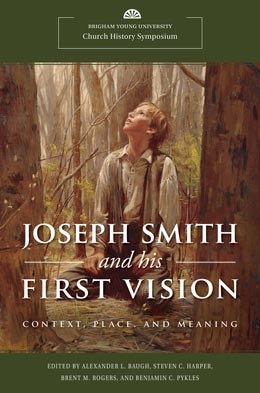Gary L. Boatright Jr., “The Sacred Grove: Its History, Preservation, and Regeneration,” in Joseph Smith and His First Vision: Context, Place, and Meaning, ed. Alexander L. Baugh, Steven C. Harper, Brent M. Rogers, and Benjamin Pykles (Provo, UT: Religious Studies Center, Brigham Young University; Salt Lake City: Deseret Book), 167‒84.
Gary L. Boatright Jr. is the operations manager for the Historic Sites Division of the Church History Department of The Church of Jesus Christ of Latter-day Saints.
As a relatively new employee of the Church History Department, I traveled to Palmyra, New York, for the first time in 2004. I made this visit with Don Enders, a seasoned curator who had spent decades researching and restoring the Church’s historic sites in the Palmyra area.[1] Much of what visitors now see and experience at the sites in New York is a result of his work. During our visit, the goal was to rechink the log home at the Smith Farm. Once we arrived in Palmyra, our plans quickly changed when we learned of a concerted effort by local Church employees and the site director to make some changes in the Sacred Grove. They proposed adding spurs off of the main trail in the grove to provide additional places for visitors to sit and contemplate the sacred event that had occurred there in the spring of 1820. I thought this sounded like a good idea, but Enders’s response to the proposal was shocking to me. He and I met on site with other representatives from Church headquarters who also vehemently expressed their opposition to the proposed additions. Throughout that week, I learned why the representatives from Church headquarters reacted the way they did.
A forest is a fragile ecosystem, especially if visitors are invited to immerse themselves in it. Small changes here and there can have a significant effect—for good or bad—on the landscape. Shortly following the Church’s purchase of the Sacred Grove in 1907, stewards made many small, well-intentioned changes to the Sacred Grove and its management. Collectively, these changes created a significant risk to the overall health and vitality of the sacred forest. Since the late 1990s, The Church of Jesus Christ of Latter-day Saints has made substantial strides in correcting the errors of the past to restore, preserve, and even expand the Sacred Grove.
Historians have written much about the First Vision and the other sacred events that occurred in upstate New York as the Lord began the Restoration of his gospel through Joseph Smith. But what about the place? What has made the Sacred Grove the place that visitors experience today? This chapter discusses the history of the grove and the effects of various management philosophies on the health and vitality of this sacred woodland.
In late 1816 Joseph Smith Sr. traveled from the Smiths’ home in Vermont to Palmyra, New York, hoping to find land his family could purchase on credit. Months later, Lucy Mack Smith and the couple’s eight children joined him in Palmyra. Joseph and Lucy Smith decided their best course of action was “to aply all our energies together and endeavor to obtain a Piece of land as this was then a new country and land was low being in its rude state.”[2] The couple considered several properties in the area, eventually deciding on a one-hundred-acre parcel south of Palmyra in what became Manchester Township. A dense old-growth forest covered the property. Determined to make a new home and a thriving farm, the family went to work clearing sections of the land for farming. Lucy remembered, “It was not long till we had 30 acres ready for cultivation.”[3] The Smiths had no intention of clearing the entire property since some areas of the land were not suited for farming. Additionally, they knew the value of forested areas for providing wild game, firewood, sap for maple sugar, and building materials.
 Looking west toward the Sacred Grove. Photography by George Edward Anderson, 1907. Courtesy of the Church History Library. © By Intellectual Reserve, Inc.
Looking west toward the Sacred Grove. Photography by George Edward Anderson, 1907. Courtesy of the Church History Library. © By Intellectual Reserve, Inc.
During this time of intense physical labor, Joseph Smith Jr. walked into what he described as “the silent grove” and experienced the First Vision.[4] As the Restoration of the gospel unfolded, the Smiths continued working the land and developed the property into a thriving farm. Following the death of their oldest son, Alvin, the Smiths made a series of poor financial decisions that ultimately led to the loss of the property. The family remained on the farm for a short time as tenants, thanks to the kindness of Lemuel Durfee, the new owner.[5] Following the Smiths’ departure from Palmyra, several families owned the property, including the Durfee, Storm, Robinson, and Weeks families. All left their mark on the landscape by clearing more land, farming more ground, and making other changes to the landscape to meet their needs. In 1860 Seth T. Chapman purchased the farm. At that time, approximately seven acres of old-growth forest remained in the northwest corner of the original one hundred acres. The property would remain with the Chapman family for decades to come.
Like those who preceded him, Chapman and his family made several modifications to the farm. They remodeled the frame home built by the Smiths, removed several structures, and expanded the barn complex on the west side of Stafford Road. Within seven years of the purchase, one Palmyra resident described the Chapman property as a “well-organized farm.”[6] Despite these changes, the Chapmans never laid an axe on the remaining section of old-growth forest. There are two accounts, both by Chapman’s son William, explaining this decision:
My father was born in this neighborhood. He was about the age of Joseph Smith when he claimed he had the vision. A short time after that a group of boys met on the road north of the Smith home and were almost tormenting young Joseph Smith. They were ridiculing and making fun of his purported vision. Joseph got so upset about it that he said to the group of boys, of which my father was one, “Come along with me and I will show you where it happened.” The boys followed him and he pointed to the spot where it happened, and my father showed me [the] spot.[7]
As great as this story is, it is not true. Seth Chapman was born in Massachusetts in 1811, and records show he continued to live in that state for many years.[8] Though Chapman never knew Joseph Smith nor was shown the location of the First Vision, he knew of Smith’s connection to the property and understood its significance to members of The Church of Jesus Christ of Latter-day Saints.
The second account is William’s response to a question about why the family never cleared the remaining section of old-growth forest:
I can explain that. Years ago my father sent for me and wished me to come at once. I found father very sick. He said, “I want to speak to you about the farm. I do not think I will live long, and the farm will go to you. I want you to take good care of the grove. I have never used an ax in the grove except to remove dead timber. I think it should be preserved, for that is where Joseph Smith, the ‘Mormon’ prophet, had his first vision.” Father died soon after this conversation, and I have done as he wished. I have never used an ax in the grove except to remove dead timber.[9]
Forty-five years after Seth Chapman purchased the farm, William and Grace Chapman hosted a delegation from Salt Lake City in December 1905. A group, which included President Joseph F. Smith, visited Palmyra on their return to Utah from the dedication of the Joseph Smith Birthplace Memorial monument in Vermont. During the group’s visit, President Smith walked through the grove of trees on the property, even stopping to have his photo taken near one of the majestic trees. Edith Smith, a member of the group, wrote, “Before leaving Mr. Chapman called on the Pres and it is supposed offered to sell the church his farm. We all hope some day the church will own . . . the grove . . . but whether it will be secured within a short space of time or in the future we cannot tell. The thought that was expressed [was] that some day it would be done.”[10]
A year and a half later, on assignment from the First Presidency and the Quorum of the Twelve Apostles, Elder George Albert Smith traveled to Palmyra with instructions to purchase the Smith Farm. After several days of discussion, Elder Smith recorded that he had “had a long talk [with the Chapmans] . . . about purchasing [their] farm and closed the deal . . . for $20,000.”[11] As he left the Chapmans’ home, Elder Smith instructed them to “take good care of the grove,” and he informally established the first management plan for the Sacred Grove. “Keep it clear of under-brush,” Elder Smith counseled, “so that it [will] not be destroyed by fire.”[12] Clearly, this was counsel from someone who lived in the arid west and not the wet east. He may not have realized that the underbrush would not dry out and pose a fire hazard; rather, it would decompose and nourish the forest. The Chapmans stayed on the farm for several years until the Church appointed a couple to manage the property.
In 1914 Church leaders called Willard and Rebecca Bean to manage the Smith Farm. Visitation at the site continued to increase seven years after the Church purchased the property, as Latter-day Saints traveled east to see the places associated with early Church history. The Sacred Grove soon became a venue for testimony meetings and other gatherings organized by members and local missionaries. Alvin Bean, Willard and Rebecca’s son, recalled: “We used to have many meetings in the Sacred Grove. People would sit on chairs, or logs or benches or planks—anything we could find to accommodate a hundred or two hundred people.”[13] In 1923 Latter-day Saints held meetings in the Sacred Grove to commemorate the centennial of the appearance of the angel Moroni to Joseph Smith. Three years later, the Sacred Grove also served as the venue for a pageant depicting several scenes from Church history. Alvin Bean remembered playing the role of young Joseph Smith, though Alvin was reluctant to do so because he did not know how he would react if he were to see an angel.[14] Every meeting and event held in the Sacred Grove affected the health of the forest. Visitors compacted the ground, furniture and other items were brought in to better accommodate visitors, and lights were strung in the trees.
After twenty-five years, the Beans’ mission came to an end. In 1939 the family said goodbye to the friends they had made, the farm they had worked, and the grove they loved. A new couple, Merlin and Echo Ellis, arrived from Utah to manage the property. Like the Beans before them, the Ellis family (who maintained the farm until 1950) welcomed an increasing number of Latter-day Saints and other visitors to the farm and the Sacred Grove.
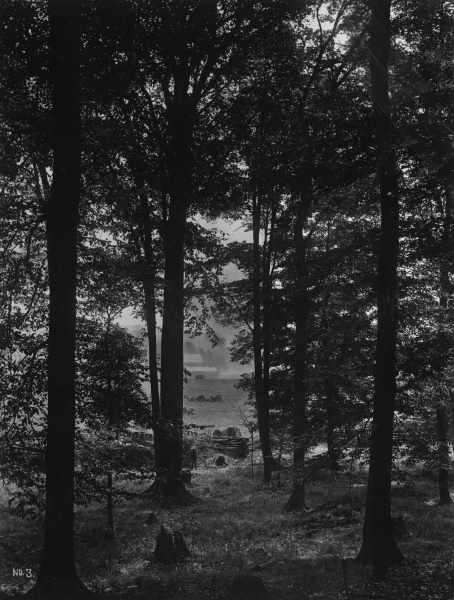 View of the Sacred Grove. Photograph by George Edward Anderson, 1907. Courtesy of the Church History Library. © By Intellectual Reserve, Inc.
View of the Sacred Grove. Photograph by George Edward Anderson, 1907. Courtesy of the Church History Library. © By Intellectual Reserve, Inc.
In 1944 the Church recruited local Boy Scout Troop 61 to conduct a survey of vegetation in the Sacred Grove. The scouts saw it as an opportunity to perform service to commemorate the hundredth anniversary of the martyrdom of Joseph and Hyrum Smith. They spent the summer identifying and documenting the species of flora in the forest. Their report noted beech trees as the most dominant species in the small woodland and identified five very large sugar maple trees, which they estimated to be over two hundred years old.[15] Two years later the Church contracted with professional tree surgeons, as they were then called, who confirmed the age of the sugar maples. These “witness trees”—so called because they had been in the forest at the time of the First Vision—soon became a favorite feature in the Sacred Grove for those who visited the site.[16]
Following its 1907 purchase of the farm, the Church did little to manage or improve the ecology of the Sacred Grove. Church caretakers focused on improving visitor access, supporting the gatherings held in the grove each year, and creating a parklike environment for visitors to enjoy. C. Orvill Stott, director of the Bureau of Information at the nearby Hill Cumorah in the late 1940s, recognized the dangers of an unmanaged forest. Broken branches, fallen trunks, and dead trees posed significant hazards to visitors. Left unmanaged, these risks could significantly increase over time. To mitigate these hazards, Stott recommended creating a management plan for the Sacred Grove. Beyond addressing the dangers posed by the trees in the grove, his plan called for a specific focus on preserving the large maple trees, or “four patriarchs,” as he called them.[17] In a letter to Presiding Bishop Thorpe B. Isaacson in 1948, Stott explained,
We have just concluded holding a series of Conference meetings in the Grove, and as I looked up from that meeting and saw those dead and dying limbs poking out in all directions like sore thumbs or possibly like Satans Imps, as they are a hazard to life and an object of neglect, I got the feeling that we are not being true to on-coming generations if we willfully allow those four Patriarchs [to] decay before our eyes. A treatment now, as recommended, will prolong their lives in a state of beauty another 100 to 200 years.[18]
“In my opinion,” Stott concluded, “the Church could not invest in any better way than to preserve these four Giants of the Sacred Grove for our posterity to appreciate.”[19]
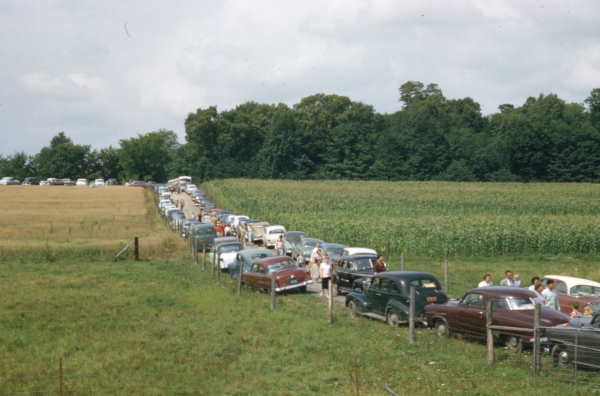 Cars lined up on the road to the Sacred Grove, ca. 1940-60. Courtesy of the Church History Library. © By Intellectual Reserve, Inc.
Cars lined up on the road to the Sacred Grove, ca. 1940-60. Courtesy of the Church History Library. © By Intellectual Reserve, Inc.
Caretakers who followed the Bean and Ellis families also worked to improve visitor access to the Sacred Grove. Workers regraded an old farm lane leading to the woodlands and allowed visitors to drive their vehicles directly to the southern end of the Sacred Grove. To accommodate the increase in vehicles, the Church cleared an area for a parking lot at the south end of the grove. Sometime later, crews paved both the road and the parking lot. This seemingly innocent improvement significantly affected the ecology of the grove. Pollution increased as visitors’ cars came and went; some visitors sat in idling cars while others made quick trips to see the grove. The increased proximity of pollution from vehicle exhaust negatively affected the health of the trees in the forest. Additionally, the drivers of many of these vehicles unknowingly transported invasive insects and other pests from thousands of miles away, threatening the health of the Sacred Grove.
In the 1960s the Church continued its efforts to treat the sacred site not as a forest but as a park. Year after year, groups of young men, young women, and others descended upon the grove, combing the forest floor to pick up every fallen leaf, twig, and branch. These Latter-day Saints thought they were providing a service by treating the Sacred Grove as they did other sacred spaces such as temples—they kept the grove clean and spotless. Unintentionally, these projects meant to beautify the grove were, in fact, killing it. A neighbor remembered what the grove looked like during this period: “The forest was open and park like, but it was literally almost a sterile environment. . . . Now many people liked this groomed look because it looked very cared for but it bore no resemblance to the forest that Joseph would have gone to.”[20]
A forest, like all other living organisms, needs nutrients to survive. Trees receive their nutrients from the soil. When branches, leaves, and dead trees fall to the ground, they decompose and replenish the soil with enriching nutrients for the next generation of trees. As groups of well-intentioned Latter-day Saints “cleaned” the grove, they literally starved the forest of needed nourishment. Lacking nutrients, the forest weakened and became more susceptible to insects and other threats. Other efforts to help the grove throughout the latter half of the twentieth century negatively affected it. Caretakers of the Sacred Grove felled many trees claimed by pest and disease. “Even the stumps were cut off at ground level,” remembered a neighbor. “There was no trace of the tree even having been there.”[21] Workers also tried to “strengthen” weakened trees by pouring concrete into cavities that had rotted. This practice led to the demise of many more trees. In its weakened condition, the Sacred Grove could no longer defend itself against its natural enemies.
The Church continued to make “improvements” to enhance visitors’ experiences. With a long history of Church members holding meetings in the Sacred Grove, the Church updated the gathering area to accommodate the ever-present demand for meetings. Benches and bleachers were brought in, carpenters built a new platform and pulpit, and workers installed a sound system and electric lighting.
For years, the management program for the Sacred Grove was simple—keep it clean like a park. As one observer noted, “It was a flawed management approach.”[22] By the mid-1990s, the health and long-term viability of the Sacred Grove was in serious jeopardy. To remedy the situation, the Church began to rethink how it cared for the grove. At this same time, a series of events put the right people in the right place to ensure the long-term preservation and expansion of the Sacred Grove.
The Church reached out in 1997 to local Palmyra forester Robert (Bob) Parrott to harvest trees from the forest for use in the reconstruction of the Smiths’ log home. This brought Parrott into contact with the site director, Chuck Canfield. One day the two walked through the Sacred Grove as Canfield explained to Parrott how the Church was exploring a more proactive approach to managing the forest. Parrott took the liberty to share his thoughts about forest management and, specifically, the Sacred Grove. As a neighbor to the Smith Farm, Parrott had walked in the grove since he was fourteen years old. As he grew into his profession, he began to look at the forest with a more professional eye. What he saw alarmed him. “What in the world are these folks doing here?” Parrott had asked himself.[23] He shared his concerns with Canfield and the actions he would take if he managed the Sacred Grove. Impressed with what he heard, Canfield organized a meeting between Parrott and Steven L. Olsen and Don Enders (both from the Church History Department), Don Leopold (a forestry and biology professor at Syracuse University), and several others. At this meeting, Church representatives discussed their desire to improve the health of the forest and to expand the size of the Sacred Grove. The group shared opinions about the problems in the grove and in its management and also discussed recommendations to preserve the grove. But for the time being, the discussion ended there.
In early September 1998, microburst winds left a trail of damage between Buffalo and Syracuse, New York. The strong winds felled hundreds of trees, including twenty large trees in the Sacred Grove. Wanting to ensure the safety of future visitors to the Sacred Grove, Reuel Reeder, the local facilities manager for the Church, reached out to Parrott and asked whether he could clean up the fallen trees and other debris. Rather than remove the debris, Parrott mitigated the hazards but left the natural material in the grove to eventually decompose and provide much-needed nutrients to the soil. Impressed with the work Parrott accomplished in a day and a half, Reeder formalized an agreement with Parrott to manage the care of the Sacred Grove. Parrott came to this new role with twenty years of forest management experience, yet his philosophy was very simple: “I provide the ingredients and nature does the cooking.”[24] Parrott’s humble approach conceals the many tasks he does on a regular basis to care for the Sacred Grove. His light touch has brought dramatic results and has impressed several in the Church, including Elder Marlin K. Jensen, former Church Historian and Recorder. Speaking of Parrott’s work, Elder Jensen stated: “When Brother Parrott took over the care of the grove some years ago, he recommended that the grove be left in as natural a state as possible. Fallen trees and limbs were left to decompose and enrich the soil. Leaves were left lying where they fell. Visitors were asked to stay on marked pathways so that the grove would be less disturbed and the soil within the grove less compacted. Within just a few years, the grove began to regenerate and renew itself in a remarkable way. Today it flourishes in a nearly pristine state, with lush vegetation and an abundance of wildlife.”[25]
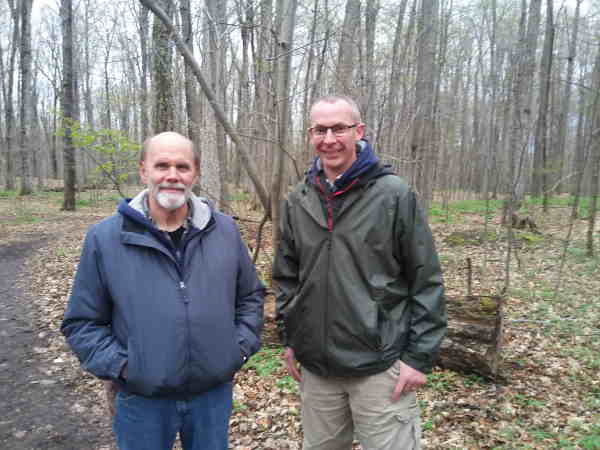 Left to right: Robert F. Parrott and Gary Boatright in the Sacred Grove. Photograph courtesy of Gary L. Boatright Jr.
Left to right: Robert F. Parrott and Gary Boatright in the Sacred Grove. Photograph courtesy of Gary L. Boatright Jr.
The Church History Department undertook a project in 2011 to document Parrott’s methods. A team traveled to the site to film Parrott discussing and performing his work. From those videos, a formal management plan based on Parrott’s techniques was developed for future caretakers of the Sacred Grove to follow.
Today the forest is healthy, vibrant, and expanding. Since the Church first purchased the farm in 1907, the Sacred Grove has expanded in size. In the 1940s the Church purchased a section of what was Hyrum Smith’s property, immediately to the north of the Smith Farm. This expanded the Church-owned portion of the woodlands from about seven to ten acres. The acquisition of other adjacent properties expanded the grove to thirty acres of mature forest.[26] The Church removed the benches, pulpit, and electrical equipment; created a new gathering area at the edge of the grove; and implemented new guidelines to keep the forest as natural as possible. Additionally, efforts to expand the size of the Sacred Grove continue today. In 2015 the Church quit mowing a field immediately to the east of the grove, thus allowing the forest to naturally reclaim the area. Today, thousands of young maple trees ten to fifteen feet in height stand in the former field. In total, thirty additional acres are in a state of regeneration today, having a range of twenty to sixty years of growth. As the former field and other areas regenerate and mature, the Sacred Grove will eventually cover 150 acres, expanding beyond the borders of the original Smith farm. This expansion offers three important results:
- Visitors will be able to experience the same type of setting that Joseph Smith experienced in 1820 when he had his First Vision.
- As the woodland grows larger, it will become stronger in defending itself against pests and diseases.
- The expanded areas will allow for an extended network of trails throughout the Sacred Grove. What once was a single horseshoe-shaped path is now a vast network of trails that distributes visitors throughout the forest, providing a quiet and reverential experience for those who visit the sacred site. As the Sacred Grove expands, so too will the trail system.
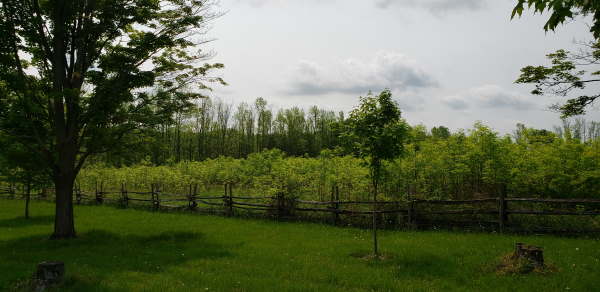 Once a field, this area is naturally regenerating into a forest, which will eventually expand the size of the Sacred Grove. Photograph courtesy of Gary L. Boatright Jr.
Once a field, this area is naturally regenerating into a forest, which will eventually expand the size of the Sacred Grove. Photograph courtesy of Gary L. Boatright Jr.
In the words of Don Enders, “We have met the enemy, and it is us!” Much of the damage done to the Sacred Grove over the years was preventable. Filled with good intentions, caretakers of the grove and staff at Church headquarters recommended, approved, and performed work in the grove to enhance the visitors’ experiences. Such was the proposal presented in 2004 when I first visited the site: provide more places for visitors to contemplate the First Vision and its influence on their lives. This idea was worthy of strong consideration, but it would have required the felling of numerous trees and would have presented a host of other potential issues, including further compaction of soil and damage to trees, roots, and other flora because visitors would be invited to leave the main trails and explore areas deeper within the forest. With tens of thousands of visitors to the Sacred Grove each year, this was reason for concern, and the proposal did not move forward.
 Today the Sacred Grove is a vibrant healthy forest reminiscent of what the Smith family experienced during their time on the farm. Photograph courtesy of Gary L. Boatright Jr.
Today the Sacred Grove is a vibrant healthy forest reminiscent of what the Smith family experienced during their time on the farm. Photograph courtesy of Gary L. Boatright Jr.
During the past two decades, the Sacred Grove has thrived under the care of Robert Parrott and the local facilities staff. The work they have done has dramatically improved the health of the grove. “We leave all the organic material in place to enrich the soil,” Parrott stated, “and the fallen logs grow moss and fungi and provide food and shelter for wildlife and ultimately . . . decay and enrich the earth.” Visitors now experience the “old growth forest ambience that Joseph [Smith] would have seen.”[27]
Despite this success, there is still cause for concern. Visitors at the Sacred Grove pose the largest threat to the site. Each year, tens of thousands of visitors walk its trails and contemplate the sacred event that occurred there. Most visitors show a tremendous amount of respect and exit the Sacred Grove having had a powerful experience in a sacred place. However, notwithstanding signage and encouragement from missionaries to be respectful, a small percentage of visitors wander off the trail, break limbs from trees, and even carve their names and the date of their visit on the trees—damage that cannot be reversed.
The First Vision represents the beginning of the Restoration of God’s work in the latter days. This moment in history has touched the lives of millions of people around the world ever since that “beautiful, clear day, early in the spring of eighteen hundred and twenty” (Joseph Smith—History 1:14). Today, the Sacred Grove stands as a witness to the event that occurred there over two hundred years ago. The Church has learned from the well-intentioned mistakes of the past and has established a plan to manage and preserve the Sacred Grove “for the good of the church, and for the rising generations” to come (Doctrine and Covenants 69:8).
Notes
Many thanks to Bob Parrott—my colleague, mentor, and friend. This chapter is a result of the many conversations Bob and I have had over the years as we walked through the Sacred Grove together and over our traditional lunch at Yellow Mills Diner.
[1] See Richard N. Holzapfel, Donald L. Enders, Larry C. Porter, and Robert F. Parrott, “Return to the Sacred Grove,” Religious Educator 11, no. 2 (2010): 147–57.
[2] Lucy Mack Smith, History, 1844–1845, p. 7, bk. 3, https://
[3] Lucy Mack Smith, History, 1844–1845, p. 7, bk. 3.
[4] Journal, 1835–1836, p. 23, https://
[5] See Donald L. Enders, “A Snug Log House,” Ensign, August 1985, 14–23.
[6] Pomeroy Tucker, Origin, Rise, and Progress of Mormonism (New York: Appleton, 1867), 13.
[7] John Wells to Joseph Fielding Smith, 17 July 1934, MS 19247, Church History Library.
[8] See “Massachusetts Births, 1841-1915,” database with images, FamilySearch, https://
[9] William Chapman as quoted in George E. Anderson, “Boy in the Picture of the Sacred Grove,” Improvement Era, May 1920, 640.
[10] Edith Ann Smith Journal and Scrapbook, 26 December 1905, Church History Library.
[11] George Albert Smith, Diaries, 10 June 1907, J. Willard Marriott Library, Special Collections.
[12] Anderson, “Boy in the Picture of the Sacred Grove,” 640.
[13] Alvin Pliny Bean, “Memories of Life on the Farm,” in Autobiography of Willard Washington Bean: Exploits of the Fighting Parson, 1868-1949, comp. Vicki Bean Topliff (Provo, UT: BYU Print Services, 2003), 321.
[14] See Bean, “Memories of Life on the Farm,” 324.
[15] See Rand Hugh Packer, “History of Four Mormon Landmarks in Western New York: The Joseph Smith Farm, Hill Cumorah, the Martin Harris Farm, and the Peter Whitmer, Sr., Farm” (master’s thesis, Brigham Young University, 1975), 60.
[16] The witness trees are believed to have been alive at the time of the First Vision in 1820; Correspondence, John D. Giles Papers, Church History Library.
[17] It is unclear why Stott refers to only four patriarchs since the Boy Scouts identified five large maple trees in the Sacred Grove. It is possible one of the trees died or was felled.
[18] C. Orvill Stott to Thorpe B. Isaacson, 14 August 1948, John D. Giles Papers, Church History Library.
[19] Stott to Isaacson, 14 August 1948.
[20] Robert F. Parrott, Oral History, 9 October 2016, 6–7, Church History Library.
[21] Parrott, Oral History, 6.
[22] Parrott, Oral History, 6.
[23] Parrott, Oral History, 6.
[24] Parrott, Oral History, 10.
[25] Marlin K. Jensen, “Stand in the Sacred Grove,” CES devotional, 6 May 2012, https://
[26] See Parrott, Oral History, 6.
[27] Parrott, Oral History, 8.
